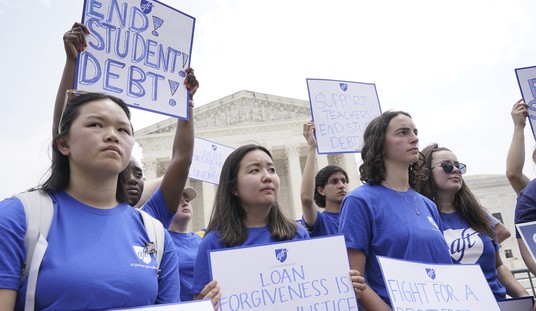WASHINGTON – President Obama is pushing ahead with a proposal to establish a government-funded pre-kindergarten education program across the country to enhance learning opportunities for under-privileged and middle-class children despite critics who question the efficacy of the initiative.
Obama used his State of the Union address to extol the virtues of early childhood education and announced plans to provide opportunities for children as young as 3 to participate. He expanded on his proposal during a Feb. 14 speech in Decatur, Ga., asserting that “education has to start at the earliest possible age.”
The president claimed every dollar invested in high-quality pre-kindergarten education ultimately saves more than $7 by, among other things, boosting graduation rates, reducing teen pregnancy, and reducing violent crime. Yet the U.S. isn’t offering enough kids educational opportunities at a time when they are “just sponges soaking stuff in.”
“Most middle-class parents can’t afford a few hundred bucks a week for private preschool,” Obama said. “And for the poor children who need it the most, the lack of access to a great preschool education can have an impact on their entire lives. And we all pay a price for that. And as I said, this is not speculation. Study after study shows the achievement gap starts off very young.”
The White House has released the outline of a plan that would expand pre-K access to practically every youngster in the country. The package comes without a specific price tag although some estimates have placed it at about $10 billion.
Obama is recommending the creation of a cost-sharing arrangement with the states through the U.S. Department of Education to offer early childhood education opportunities to 4-year-olds from low- and moderate-income families. States would receive an unspecified incentive if they included middle-class kids in the program.
In order to qualify for the federal monies states would be required to establish that their pre-K programs adopt standards for early learning, hire qualified teachers, and create an assessment program to chart success or failure. The states also would be encouraged under the proposal to set up all-day kindergarten programs.
Grover J. “Russ” Whitehurst, director of the Brown Center on Education Policy at the Brookings Institution, reported that 39 states now offer state-funded pre-K, with 31 of those states having programs that are targeted for low-income families. The National Institute for Early Education Research, a research center at Rutgers University in New Jersey, reported that as of 2011 four percent of the nation’s 3-year-olds and 28 percent of 4-year-olds were enrolled in some sort of state-supported preschool education program totaling more than 1.3 million children. Only 12 states, according to NIEER, provided enough per-child funding to meet established quality standards.
Whitehurst said when children enrolled in Head Start and other public programs, including special education, are combined with those in state-funded pre-K, 42 percent of the nation’s 4-year-olds are enrolled in a taxpayer funded, center-based preschool programs.
“Even as the nation begins to emerge from the economic downturn, few states are adding significantly to enrollment and the educational quality of state pre-K is taking a backseat to budget cutting—even though the number of students who need good preschool programs has risen,” the organization said in its report, “The State of Pre-School 2011.”
Education experts generally lauded Obama’s proposal.
“Long ago, we mistakenly believed that children did not really learn anything until the ‘age of reason’ at 7,” said Kenneth Dodge, an expert on early childhood development at Duke University in Durham, NC. “Now we know that early experiences are crucial to lifelong outcomes. We now have evidence that high-quality preschool experiences improve academic outcomes that persist at least through third grade. If we are investing in education from kindergarten forward, we should invest in preschool as a way to improve those outcomes.”
W. Steven Barnett, director of the National Institute for Early Education Research, said he was thrilled by the commitment from the White House.
“The president’s pre-K proposal would help states provide high-quality preschool education for low- and middle-income families, which is crucial considering that children of lower income groups start kindergarten more than a year behind in language and math than their upper income peers,” Barnett said.
“Among children from low-income families, more than one in three attends no preschool program at age 4 and most who do attend a program do not receive a high-quality education.”
The administration’s plan, he said, “will put children on an early path to success. This proposal improves opportunity for everyone, offering a hand up to lower and middle-income families that will help them reach the American dream.”
But support was hardly unanimous and there already is an indication that the White House package will encounter problems making it through the Republican-controlled House. Critics cite problems with Head Start, a Great Society program that offers education, health and nutrition services to low-income children and their families, as a reason to be wary of government-supported pre-K.
A 2011 report issued by the Department of Health and Human Services concluded that “the benefits of access to Head Start at age four are largely absent by first grade for the program population as a whole. For 3-year-olds, there are few sustained benefits, although access to the program may lead to improved parent-child relationships through 1st grade, a potentially important finding for children’s longer term development.”
That report, and others, has caused some lawmakers to question the value of enhanced pre-K.
“Most importantly, will this plan be effective?” asked Rep. John Kline (R-Min.), chairman of the House Education and the Workforce Committee. “The federal government has a poor track record of managing early childhood education initiatives, with mounting evidence that Head Start may not be helping students as much as we had hoped.”
Kline said he is willing to have “a serious dialogue” with administration officials “if they are willing to offer less rhetoric and more facts.”
“I am confident we can find ways to promote parental choice, ensure an appropriate federal role in education and serve our nation’s most vulnerable youth – without offering more empty promises to our children or adding more debt onto the backs of taxpayers,” Kline said.
Some education experts dismissed the administration’s initiative.
“The trouble with federal-government-funded preschooling is that we have 47 years of experience with it — and it doesn’t work,” said Andrew J. Coulson, director of the Center for Educational Freedom at the Cato Institute. “The federal Head Start pre-K program was created in 1965, and, despite decades of concerted efforts to refine and improve it, it has virtually no measurable effects that last to the end of the third grade—or even the first.”
Of the very few and modest effects that have been found at the end of the third grade, Coulson said, some are actually negative.
“That is what federal government pre-K has accomplished with $200 billion and half a century of effort,” he said. “Is that a sensible basis for expanding federal government pre-K?”
But proponents cite the results of other studies, particularly the Perry Preschool Project, as evidence establishing the worthiness of early childhood education. That study was based on 3- and 4-year-old students who attended a preschool program at Perry Elementary School in Ypsilanti, Mich., in the early 1960s, tracing their development over decades and comparing their outcomes to other children who did not attend preschool.
The study found, among other things, that the Perry group had a higher high school graduation rate, were less likely to serve time in prison, experienced fewer out-of-wedlock births, experienced a higher median monthly income, and were less likely to receive government assistance. It further determined that every dollar spent on preschool education resulted in a $16 return.
Researchers from the Frank Porter Graham Child Development Institute at University of North Carolina recently looked into the pre-K program in Georgia, one of the few states offering universal access and generally considered one of the nation’s best.
“Children in Georgia’s pre-K program exhibited significant growth during their pre-K year across all domains of learning: language and literacy skills, math skills, general knowledge and behavioral skills,” said Ellen Peisner-Feinberg, the project’s senior scientist. “For many areas, this indicated that they progressed at an even faster rate than would be expected for normal developmental growth.”
Peisner-Feinberg’s team also determined that Georgia’s program was valuable to children who were Spanish-speaking dual-language learners. “They made gains in both English and Spanish, even though the primary language of instruction was English,” she said.
North Carolina, which offers a state program targeting low-income students, also has shown positive results. Known as the Abecedarian Project, it determined that by age 21, participants earned higher reading and mathematics test scores, had a greater likelihood of being enrolled in college, and were less likely to become teen parents.
Still, some who have questions about the efficacy of the Obama proposal, like Whitehurst at Brookings, maintain there exists a dearth of research into the subject and what there is offers a mixed bag, characterizing the Georgia study as showing preschool provides “impacts that are at best very small and do not pass a cost-benefit test.”
“This thin empirical gruel will not satisfy policymakers who want to practice evidence-based education,” he said.









Join the conversation as a VIP Member